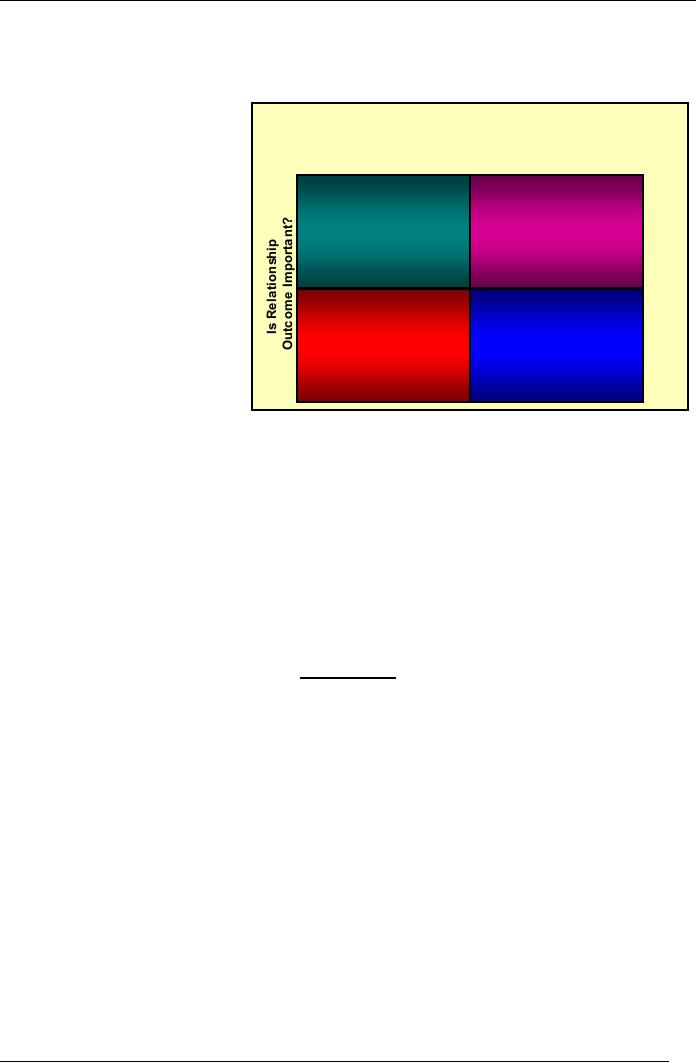 |

Human
Resource Management
(MGT501)
VU
Lesson
36
CONFLICT
AND NEGOTIATION
After
studying this chapter, students should be
able to understand the
following:
A.
Conflict
B.
Conflict and Negotiation
CHAPTER
OVERVIEW
This
lecture takes an in-depth
look at conflict management
and negotiation, key aspects
of contemporary
organizational
behavior. After examining the two
views of conflict, the consequences of
conflict, and the
types
and levels of conflict, the
chapter discusses culture and
conflict, conflict management
styles,
organizational
sources of conflict, and
conflict management strategies.
The chapter goes on to
explore
negotiation.
A.
Conflict
Conflict
is the process in which one party
perceives that its interests
are being opposed or negatively
affected
by another party. Conflict is a process
in which people disagree over significant
issues, thereby
creating
friction between parties.
Conflict can exist when
people have opposing interests,
perceptions, and
feelings;
when those involved
recognize the existence of differing
points of view; when the disagreement
is
ongoing;
and when opponents try to prevent
each other from
accomplishing their goals.
Although conflict
can
be destructive, it can also be beneficial
when used as a source of
renewal and creativity.
Competition,
rivalry
between individuals or groups
over an outcome that both
seek, is not the same as
conflict. In
competition,
there must be a winner and a
loser; with conflict, people
can cooperate so that no one
wins or
loses.
Organizational
conflict occurs
when a stakeholder group
pursues its interests at the
expense of other
stakeholders.
Given the different goals of
stakeholders, organizational conflict is inevitable.
Conflict is
associated
with negative images, such
as unions getting angry and
violent, but some conflict
can improve
effectiveness.
When conflict passes a
certain point, it hurts an
organization.
I.
Transitions in Conflict Thought
Under
traditional
view conflict
is a process in which
people
disagree over significant issues,
creating friction
between
parties. One view of conflict is
that it is
Traditional
dysfunctional
and harmful to organizations,
because the
struggle
over incompatible goals is a waste of
time that
View
prevents
people and organizations
from being
productive
and reaching their
potential. On the other
hand,
interactionist
view states
that when conflict is
Human
based
on issues rather than personalities, it
can enhance
Relations
Interactionist
problem
solving and creativity. Open
discussions of
View
View
differing
viewpoints allows for a
thorough consideration
of
alternatives and their
consequences in the course of
decision
making. Conflict can also
increase motivation
and
energize people to focus on a task.
Human
relation
view
states that Conflict is a natural
occurrence and we should accept
conflict
.
164

Human
Resource Management
(MGT501)
VU
II.
Conflict Good or Bad
Conflict
can have both positive
and negative consequences. On the
positive side, conflict can
bring energy
to
a competition and focus participants on
the task at hand. It can
also increase group cohesion
and
stimulate
open discussion of issues. On the
negative side, conflict can
cause participants to lose sight
of
common
goals and focus on winning
at all costs. In addition, it
can lead to distorted judgments
and a lack
of
cooperation. Finally, the losers in a
conflict feel demoralized and
lose motivation; this loser effect
harms
long-term
relationships and overall organizational
performance.
III.
How can conflict improve
effectiveness?
Conflict
can overcome inertia and
introduce change, because
conflict requires an organization to
reassess its
views.
Different views are
considered, and the quality of
decision-making is improved.
IV.
Types and levels of Conflict
There
are four types of conflict.
Inter-group conflict
occurs
when groups within and
outside the
organization
disagree
on
various
issues.
Level
of conflict Type of
conflict
Interpersonal
conflict is due to differences in
goals,
values,
and styles between two or
more people who
are
required
to interact. Intra group conflict
occurs
Within
and between
Organization
within
a work group over goals
and work
organizations
procedures.
Intrapersonal conflict is a
person's
Within
and
Group
internal
conflict over divergent goals,
values, or
between
groups
roles.
Inter group conflict can
occur at two levels
which
are horizontal and vertical.
Horizontal
Within
and between
Individual
conflict
takes place between
departments or groups
at
individuals
the
same level of the organization. In
contrast,
vertical
conflict occurs between
groups at different levels of the
organization.
Types
of Conflict
Task
conflict: Conflicts over content
and goals of the work
Relationship
conflict: Conflict based on interpersonal
relationships
Process
conflict: Conflict over how
work get done
V.
Individual Conflict Management
Styles
a.
The
obliging style of conflict management
is
based on low concern for
self, high
concern
for others, and
focusing
on the needs of
others
while satisfying or
Conflict
Man agement Styles
ignoring
personal needs.
Concern
for Self
Low
High
This
works best when
High
issues
are unimportant,
Integrating
Obliging
knowledge
is limited,
there
is long-term give
and
take, and the person
Compromising
managing
the conflict
has
no power.
Dominating
Av
oiding
b.
The
avoiding style is
Low
based
on low concern
for
self and others and
a
focus
on suppressing,
setting
aside, and ignoring the
issues. This is appropriate when the
conflict is too strong
and
parties need to cool
off.
165

Human
Resource Management
(MGT501)
VU
c.
The
integrative style shows
high concern for self
and for others and
focuses on
collaboration,
openness, and exchange of
information. This is used when issues
are
complex,
when commitment is needed, when dealing
with strategic issues, and
when long-
term
solutions are required.
d.
The
dominating style shows
high concern for self,
low concern for others,
and focuses
on
advancing own goals at any
cost. This is used when time is short,
issues are trivial,
all
solutions
are unpopular, and an issue
is important to the party resolving the
conflict.
e.
The
compromising style shows
moderate concern for self
and others and focuses
on
achieving
a reasonable middle ground
where all parties win. This
is used when goals
are
clearly
incompatible, parties have equal
power, and a quick solution
is needed.
VI.
Manager's ways to manage conflict.
Managers
can manage conflict by either
preventing or reducing high
levels of conflict or stimulating
low
levels
of conflict. To do this, managers can
apply a behavioral approach or an attitudinal
approach. The
behavioral
approach targets the behavior
causing the conflict, while the
attitudinal approach targets
the
roots
of the conflict, including people's
emotions, beliefs, and
behaviors. Behavioral methods
include
enforcing
rules, separating the parties,
clarifying tasks, having a common enemy
or outside competition,
and
increasing
resources and rewarding cooperation.
Attitudinal methods include having a common
enemy,
rotating
members, increasing resources,
and team-building and organizational development
(OD). To
stimulate
conflict, managers can
introduce change, increase
task ambiguity, or create
interdependency.
B.
Conflict and Negotiation
Stakeholders
compete for the resources
that an organization produces.
Shareholders want dividends,
employees
want raises. An organization must manage
both cooperation and competition
among
stakeholders
to grow and survive. All
stakeholders have a common goal of
organizational survival, but not
all
goals are identical.
o
Negotiation
It
is the process used by two or
more parties to reach a mutually
agreeable arrangement to exchange
goods
and
services. Managers need negotiating
skills to be effective in today's global,
diverse, dynamic,
team-
oriented
business environment. Culture significantly
affects the negotiation process.
Negotiators from
masculine
cultures emphasize assertiveness
and independence, which can
cause them to see negotiation as a
competition
and spur them to win at all
costs. Negotiators from
cultures comfortable with uncertainty
will
take
a creative, problem-solving approach,
while those from high
uncertainty-avoidance cultures
will
emphasize
bureaucratic rules and
procedures. Power-distance,
individuality-collectivism, high or
low
context,
emotion, and time-orientation
dimensions also affect
negotiation.
Beyond
a certain point, conflict hurts the
organization and causes decline.
Managers spend time bargaining,
rather
than making decisions. An organization in
decline cannot afford to spend time on
decision-making,
because
it needs a quick response to
recover its position.
Group's battle for their
interests, no agreement is
reached,
and the organization floats along,
falling prey to inertia.
Bargaining
issues in negotiation process
can be divided into three
categories: mandatory, permissive,
and
prohibited.
Mandatory
Bargaining Issues--Fall
within the definition of wages,
hours, and other
o
terms
and conditions of employment.
Permissive
Bargaining Issues--May be
raised, but neither side
may insist that they
be
o
bargained
over.
Prohibited
Bargaining Issues--Are
statutorily outlawed.
o
166

Human
Resource Management
(MGT501)
VU
o
Negotiation
Strategies
Figure
shows
four negotiating strategies based on the
importance of the substantive outcome and
the
importance
of the relationship outcome. These four
strategies are trusting
collaboration, firm
competition,
open
subordination, and
active
avoidance.
Trusting
collaboration
is a win-win
Four
Negotiating Strategi es
strategy
most appropriate when
both
the substantive
task
Ye
s
Is
Sub stantive Outcome
Important?
No
outcome
and the relationship
Ye
s
outcome
are important. Firm
competition
is used when the
Trusting
Open
substantive
task outcome is
Colla
boratio n Subordination
important
but the relationship
outcome
is
not.
Open
subordination
is applied when
the
task outcome is
not
important
but the relationship
Firm
Active
outcome
is. Active avoidance
is
Competition
Avo
idance
useful
when neither the task
outcome
nor the relationship
outcome
is important.
No
When
two parties are unable
to
come
to agreement
during
negotiations,
they may bring in a
third
party to help resolve the differences.
Conciliation and consultation focus on
improving interpersonal
relations
to foster constructive discussion of issues.
Mediation considers both interpersonal
and substantive
issues
and relies on formal evaluation of
positions plus persuasion to bring
about a non-binding
solution.
Arbitration,
a legally binding process in
which the arbitrator imposes a
solution, can be used when
all other
methods
have failed and the conflict
must be urgently
resolved.
Common
mistakes made when negotiating include:
Irrational
escalation of commitment; thinking the pie is
fixed; winner's curse; and
overconfidence. Avoiding
these
common mistakes requires managers to be
aware of the issues, be thoroughly
prepared, and be
willing
to
rely on expert opinion to reduce the
possibility of making mistakes.
KEY
TERMS
Conflict
Conflict
is the process in which one party
perceives that its interests
are
being
opposed or negatively affected by another
party.
Task
conflict
Conflicts
over content and goals of
the work
Relationship
conflict
Conflict
based on interpersonal relationships
Process
conflict
Conflict
over how work get
done
Vertical
conflict
It
occurs between groups at
different levels of the
organization.
Horizontal
conflict
It
takes place between
departments or groups at the same level
of the
organization.
Negotiation
It
is the process used by two or
more parties to reach a mutually
agreeable
arrangement
to exchange goods and
services.
167
Table of Contents:
- INTRODUCTION TO HRM:Growing Importance of HRM, Road Map of the Course
- ESSENTIALS OF MANAGEMENT:Concepts and Essential of Management, Manager’s Roles
- ORGANIZATION AND COMPONENTS OF ORGANIZATION:Open versus Closed Systems, The Hawthorne Studies
- PEOPLE AND THEIR BEHAVIOR:Why to work in organizations?, The Goals of Organizational Behavior
- INDIVIDUAL VS. GROUP BEHAVIOR:What Are Roles?, Problem solving Team
- PERSONNEL MANAGEMENT TO HUMAN RESOURCE MANAGEMENT:Records and Administration, Competitive Advantage
- HRM IN A CHANGING ENVIRONMENT:Productivity, New Trends at Work Place
- How organization Cultivate a Diverse Workforce, STEPS TOWARD MANAGEMENT OF DIVERSITY
- FUNCTIONS AND ENVIRONMENT OF HRM:Compensation and Benefits, Safety And Health, Interrelationships of HRM Functions
- LINE AND STAFF ASPECTS OF HRM:Authority, Line versus Staff Authority, Staff Manager
- LEGAL CONTEXT OF HR DECISIONS:Doing the Right Thing, Affirmative Action, Unintended Consequences
- HUMAN RESOURCE PLANNING (HRP):Benefits of HR Planning, Forecasting Human Resource Availability
- STRATEGIC PLANNING AND HRIS:HR’s Strategic Role, Human Resource Information System, Common HRIS Functions
- JOB ANALYSIS:Purposes of the job Analysis, Questions Job Analysis Should Answer
- JOB ANALYSIS:Methods of Collecting Job Analysis Information, Observation, Source of Data
- JOB ANALYSIS (CONTD.):SURPLUS OF EMPLOYEES FORECASTED, Diversity through Recruiting Efforts
- SOURCES OF RECRUITMENT:ALTERNATIVES TO RECRUITMENT, Quantity of the Applicants, Quality of the Applicants
- SELECTION:Initial Screening, Advantages of Successful Screening
- SELECTION TESTS:Characteristics of Properly Designed Selection Tests, Guidelines for Conducting an Interview
- SELECTION PROCESS… CONTD:Background Investigations, Physical Exam, Selecting Managers
- SOCIALIZATION:Compensation and Benefits, Team Membership, Stages in socialization Process, Training and Development Trends
- TRAINING AND DEVELOPMENT:Learning, Phases of Training, Why Transfer of Training Fails
- MAXIMIZING LEARNING:Following up on Training, Repetition, Feedback, Purposes of T & D
- CAREER MANAGEMENT:Individual career planning, Career Planning and Development Methods
- PERFORMANCE:Determinants of Job Performance, Why is performance measured?, Performance Management
- PERFORMANCE APPRAISAL:What to Evaluate, The Appraisal Interview, PROBLEMS IN PERFORMANCE APPRAISAL
- JOB EVALUATION AND PRICING:THE APPRAISAL PERIOD, Ranking method,
- COMPENSATION SYSTEM:Pay, Job Pricing, Compensation: An Overview, Compensation Surveys
- BENEFITS:Total Compensation, Discretionary Benefits (Voluntary), Workplace Flexibility
- ROLE OF MONEY IN PERFORMANCE OF EMPLOYEES:Types of Pay-for-Performance Plans, Empower Employees
- MOTIVATION:The Motivation Process, Motivational Theories, Challenges of motivating employees
- OCCUPATION, HEALTH & SAFETY:Physical Conditions, Accident Investigation, Smoking in The work place
- STRESS MANAGEMENT:Symptoms of Stress, Managing Stress,
- COMMUNICATION IN ORGANIZATION:Burnout, Social Support at Work & Home, Communication in organization, Meetings
- TRADE UNIONS:Collective Bargaining, The HRM Department in a Nonunion Setting, Phases of Labor Relations
- CONFLICT AND NEGOTIATION:Transitions in Conflict Thought, Individual Conflict Management Styles
- POWER AND POLITICS:Sources of Power, Advantages and Disadvantages of PowerPower and Politics in Context
- EMPLOYEE RIGHTS AND DISCIPLINE:Contractual Rights, Management Rights, Disciplining Employees,
- DISCIPLINE (CONT...):Factors to Consider when Disciplining, Disciplinary Guidelines, Employee Separations
- LEADERSHIP:The Leader’s Behavior, Situational Theories of Leadership, Becoming a Leader
- REVISION (LESSON 12-21):Plans, Job Specification, Human resource planning, Selection Process, Corporate Culture
- REVISION (LESSON 22-26):Training, Case Study Method, Training, Performance
- REVISION (LESSON 27-35):Classification Method, Compensation, Empowerment, Mediation
- INTERNATIONAL DIMENSIONS OF HRM:Global Corporation, Type of staff members, Approaches to Global Staffing
- CONCLUSION & REVIEW:Strategies for Gaining Competitive Advantage, High-performance Work System